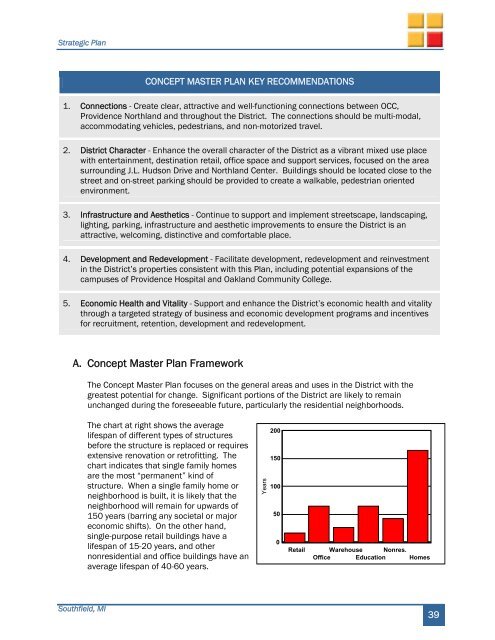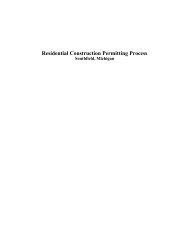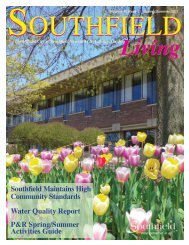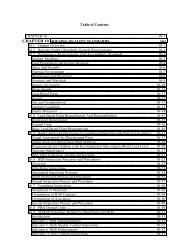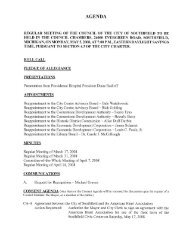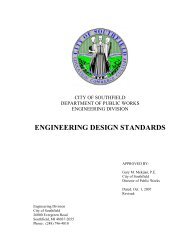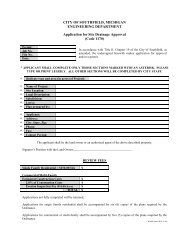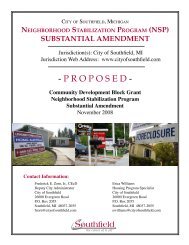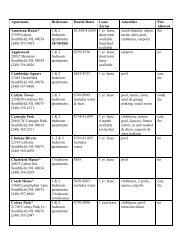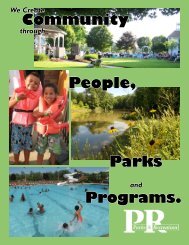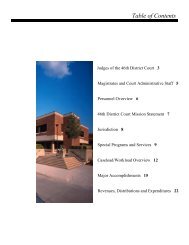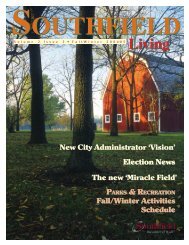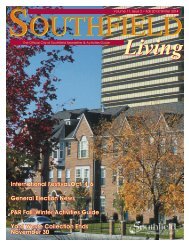Full Strategic Plan.pdf - City of Southfield
Full Strategic Plan.pdf - City of Southfield
Full Strategic Plan.pdf - City of Southfield
You also want an ePaper? Increase the reach of your titles
YUMPU automatically turns print PDFs into web optimized ePapers that Google loves.
<strong>Strategic</strong> <strong>Plan</strong><br />
CONCEPT MASTER PLAN KEY RECOMMENDATIONS<br />
1. Connections - Create clear, attractive and well-functioning connections between OCC,<br />
Providence Northland and throughout the District. The connections should be multi-modal,<br />
accommodating vehicles, pedestrians, and non-motorized travel.<br />
2. District Character - Enhance the overall character <strong>of</strong> the District as a vibrant mixed use place<br />
with entertainment, destination retail, <strong>of</strong>fice space and support services, focused on the area<br />
surrounding J.L. Hudson Drive and Northland Center. Buildings should be located close to the<br />
street and on-street parking should be provided to create a walkable, pedestrian oriented<br />
environment.<br />
3. Infrastructure and Aesthetics - Continue to support and implement streetscape, landscaping,<br />
lighting, parking, infrastructure and aesthetic improvements to ensure the District is an<br />
attractive, welcoming, distinctive and comfortable place.<br />
4. Development and Redevelopment - Facilitate development, redevelopment and reinvestment<br />
in the District’s properties consistent with this <strong>Plan</strong>, including potential expansions <strong>of</strong> the<br />
campuses <strong>of</strong> Providence Hospital and Oakland Community College.<br />
5. Economic Health and Vitality - Support and enhance the District’s economic health and vitality<br />
through a targeted strategy <strong>of</strong> business and economic development programs and incentives<br />
for recruitment, retention, development and redevelopment.<br />
A. Concept Master <strong>Plan</strong> Framework<br />
The Concept Master <strong>Plan</strong> focuses on the general areas and uses in the District with the<br />
greatest potential for change. Significant portions <strong>of</strong> the District are likely to remain<br />
unchanged during the foreseeable future, particularly the residential neighborhoods.<br />
The chart at right shows the average<br />
lifespan <strong>of</strong> different types <strong>of</strong> structures<br />
before the structure is replaced or requires<br />
extensive renovation or retr<strong>of</strong>itting. The<br />
chart indicates that single family homes<br />
are the most “permanent” kind <strong>of</strong><br />
structure. When a single family home or<br />
neighborhood is built, it is likely that the<br />
neighborhood will remain for upwards <strong>of</strong><br />
150 years (barring any societal or major<br />
economic shifts). On the other hand,<br />
single-purpose retail buildings have a<br />
lifespan <strong>of</strong> 15-20 years, and other<br />
nonresidential and <strong>of</strong>fice buildings have an<br />
average lifespan <strong>of</strong> 40-60 years.<br />
Years<br />
200<br />
150<br />
100<br />
50<br />
0<br />
Retail<br />
Warehouse Nonres.<br />
Office Education Homes<br />
<strong>Southfield</strong>, MI<br />
39


